- Corah exhibited their goods at the 1851 Great Exhibition at Crystal Palace
- In 1865 the St Margaret’s Works was the largest factory of its kind in Leicester
- The company was the first in Leicester to introduce electric lighting to a factory in 1882
A family business
Corah was established by Nathaniel Corah, who began buying hosiery in Leicester to sell in Birmingham in 1815. He was born in Barlestone, Leicestershire in 1777 and trained as a frame-smith to produce garments on a knitting frame. Every Saturday morning Nathaniel would meet in The Globe with stockingers who had goods to sell. He would examine the goods, make bids for what he wanted, and sell the stockings elsewhere.
In its early years the company relied on domestic outworkers but by the 1820s Nathaniel Corah had begun to introduce the factory system, purchasing premises in both Leicester and Birmingham. In 1830 his sons John, William and Thomas become partners in the company of N. Corah and Sons Ltd.
Nathaniel died a year later but, with the sons at the helm, the company continued to prosper and expanded its premises in Leicester and Birmingham. In 1851 the company exhibited an ‘extensive assortment of hose, wool vests and drawers, fancy wool cuffs and sleeves, hoods, hats and bonnets, and ladies' wool paletots (jackets)’ at the Great Exhibition at Crystal Palace. By the late1850s the company had purchased Hine and Mundella’s steam-powered circular knitting machines from Nottingham to undercut other makers such as John Biggs of Leicester and began a programme of rapid expansion.
St Margaret’s Works
In 1865 Nathaniel’s grandson, Edwin Corah, laid the foundation stone for the St Margaret’s Works. It was designed by Leicester architect William Jackson and built on a four acre site in the shadow of St Margaret’s Church (between what is now Vaughan Way and the River Soar) At the time it was the largest factory of its kind in Leicester. It had a vast range of north lit workshops running down to an engine house, with a 145 foot chimney, near the river.
The following year Edwin’s sister, Jennie, started the large 50 horsepower beam engine which powered the 50 rotary machines, 47 circulars and 77 sewing machines in the St Margaret’s Works. Twenty eight hand frames were also still in use for high quality work. The beam engine was made by Messrs. Joseph Ryde and Gimson & Co. of Leicester. The company commemorated the opening of the St Margaret’s Works with an Inaugural Fete in 1866 for employees and friends.
The ‘St Margaret’ trademark
During the 1870s the company expanded the range of products it produced; new additions included bathing wear and football jerseys. All products carried Corah’s ‘St Margaret’ trademark, which took its name from the neighbouring church. This trademark was one of the first to be registered for knitted goods. By the time it was registered in 1876, it had represented the goods of Corah’s of Leicester for ten years.
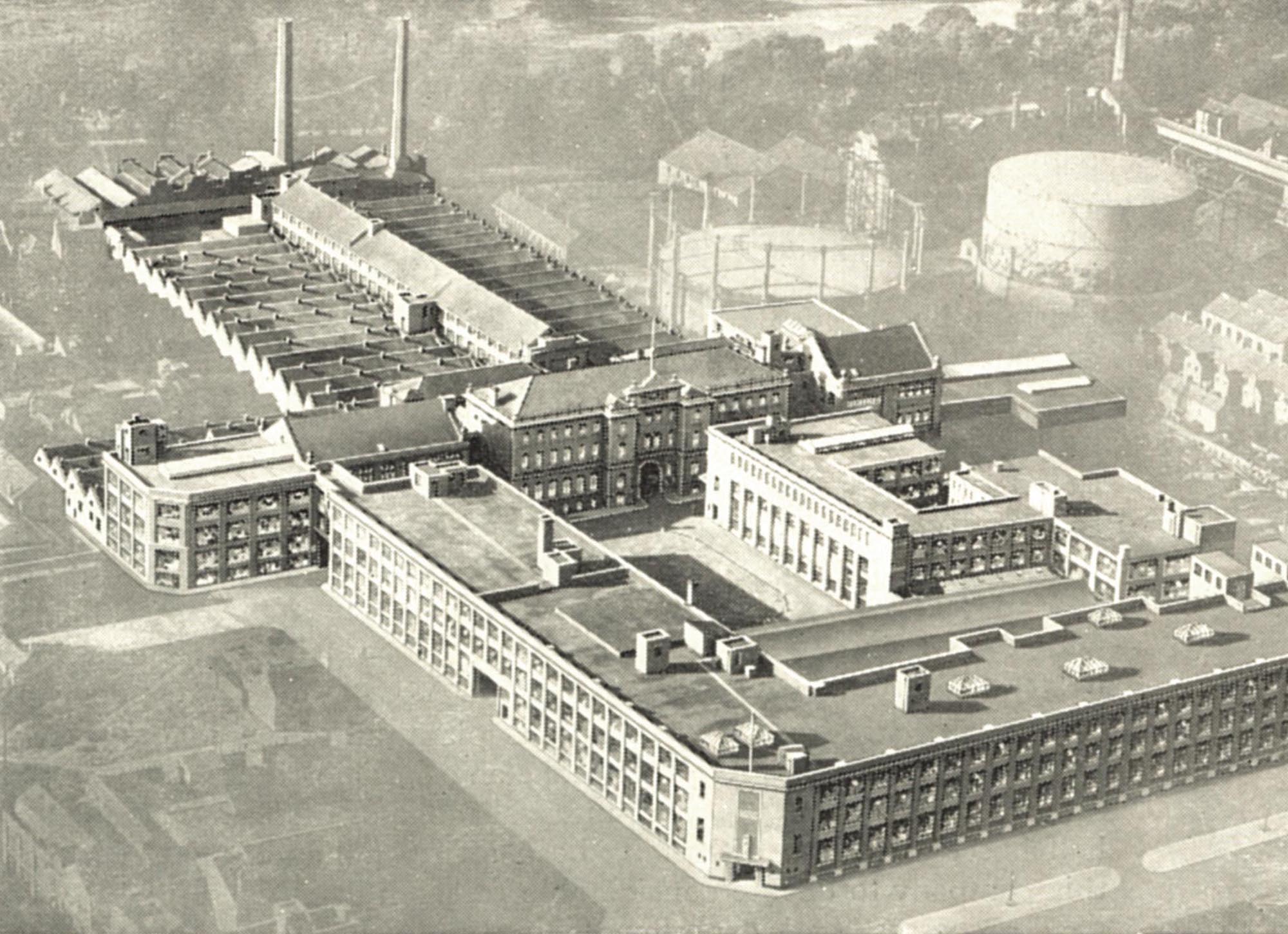
Corah celebrates its success with its employees
By the 1880s the company needed more space. The first extension was in 1882, when the company was the first in Leicester to introduce electric lighting to a factory. Once again, the developments were celebrated as employees and their wives joined influential citizens for supper and entertainment at the St Margaret’s Works. The following day the company provided a tea and entertainment for over 1000 local elderly poor people. By the time of the third extension in 1886 the company had extended the celebrations to three events. This was during the time when the company traded as ‘Cooper, Corah and Sons Limited’. The company continued to prosper and nine more extensions were completed by 1914, by which time the firm was again known as ‘N. Corah and Sons’.
Corah and the Great War
During the First World War over 330 male staff joined the Forces. This was about half of the male staff of the company. However, St Margaret’s Works still produced over ten million knitted items for the government during the four years of war. These ranged from face cloths to football jerseys and woollen helmets to woollen stockings. Unfortunately, 39 employees and a member of the Corah family lost their lives in the First World War. A memorial plaque containing all their names was placed at the front of the factory and the directors established an aid fund in their memory, known as the Leslie Corah Memorial Fund.
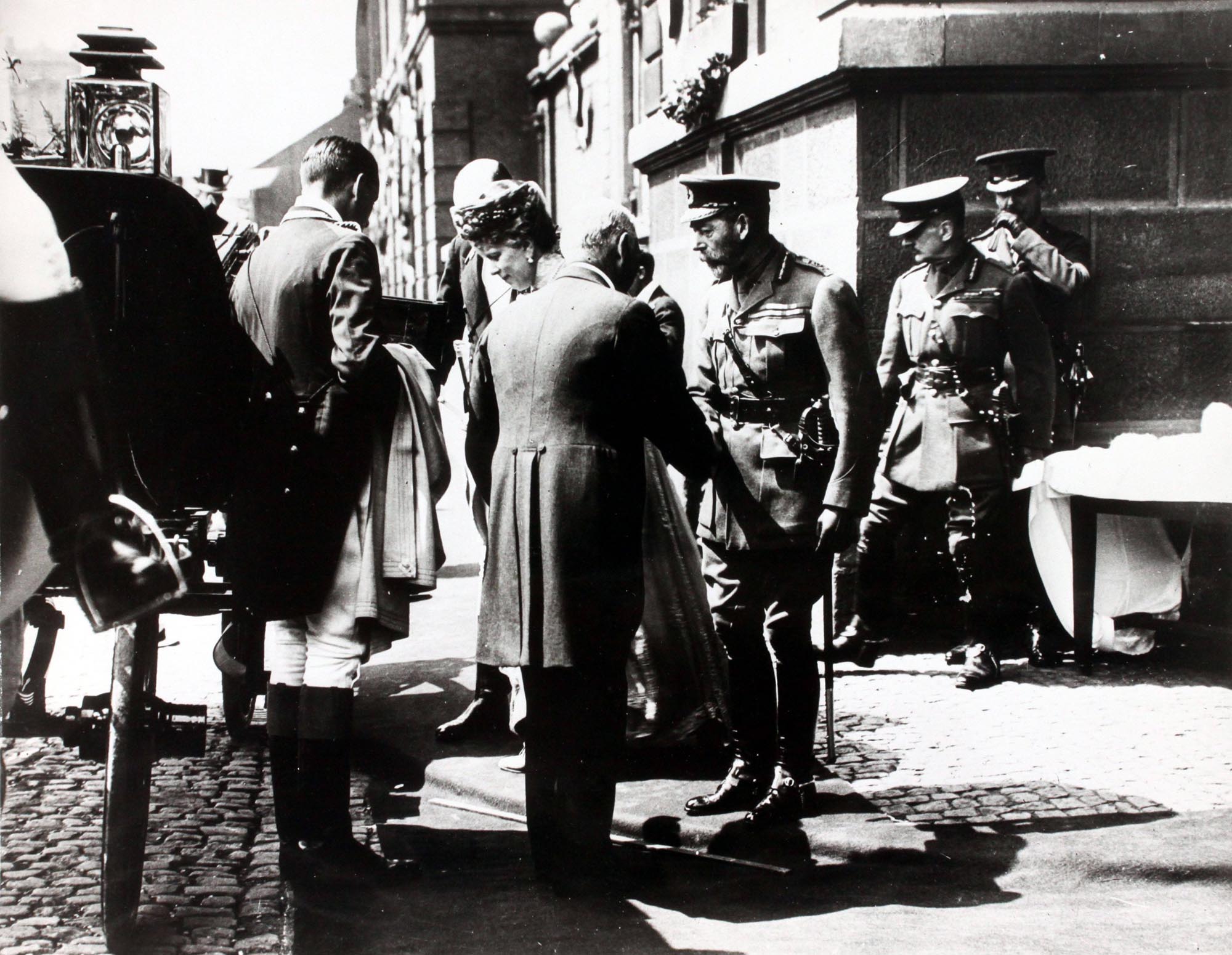
St Margaret’s Works and its famous visitors
The St Margaret’s Works received many visitors over the years which included international sports teams and members of the Royal Family. King George V and Queen Mary visited in 1919 and Queen Elizabeth II visited in 1958. In 1926 Mr Israel Seiff of Marks and Spencer visited to establish a unique relationship between the two companies. Mr Seiff was looking for a manufacturer with a well-known trademark to supply Marks and Spencer with knitted items, which Corah did for nearly 80 years.
Although difficult years for the hosiery industry, the relationship with Marks and Spencer meant that the 1930s were a period of expansion of Corah. Between the two World Wars more than ten further extensions were built to the St Margaret’s Works. Warehouses in other cities were closed and production and distribution of goods were centralised in Leicester.
Corah supports the war effort
At the outbreak of World War II Corah had 4,500 employees but over half of that number left to join the Services or undertake war work. Regardless of the reduced workforce the company produced 26 million knitted items for the government and processed around 250 million clothing coupons. The engineering department was also extended to allow for the production of 80,000 gun parts and 30,000 parts for tank landing craft. In addition, there were changes to the physical space at St Margaret’s Works with a third of the space being used by the Admiralty Victualing Stores, Standard Telephone and Cables Ltd and other hosiery firms. Marks and Spencer even moved some of their offices and staff to the site. The St Margaret’s Works fire brigade was extended, an ambulance brigade was formed and a platoon of the Local Defence Volunteers was established, known as ‘Corah’s LDVs’. Of the 850 male and female staff that joined the Services, sadly 33 of them lost their lives, including family member, Peter Corah. A second memorial plaque was erected at the front of the factory.
Employee welfare at the heart of the company
Corah was a major employer in Leicester, with over 2,000 employees in 1919 rising, at its height, to 6,800 by 1969. It was predominantly a family run business and employees were well provided for. As early as the 1890s they enjoyed paid holidays and in 1920 the company purchased four acres of land for the St Margaret’s Works Sports Association. The company had always encouraged the sporting interests of employees and first held an annual sports event in the 1870s. One member of the ‘Cooper Corah’ cricket team played in the England team which toured Australia in 1904/5 and in the 1960s and 70s the firm’s football team was prominent in the Leicester City Football League. Progress on all the sports activities was reported, with other news and information, in the quarterly staff magazine, ‘Encore’. In 1936 the first fully equipped works canteen in Leicester opened at St Margaret’s Works and in the same year the company established a staff pension scheme. By 1946 the on-site ambulance room was upgraded to a fully equipped surgery.
Quality control
Product quality was very important to Corah. In 1939 the company opened a testing and analytical department. In response to the post-war labour shortage the company established an on-site training centre in 1944, which dramatically reduced the amount of time staff spent learning processes. In 1946 a quality control department was opened, followed a few years later by the introduction of work study.
St Margaret’s Works today
Despite all the innovation, good working practices, quality products and special relationship with Marks and Spencer, Corah was acquired by Coats Viyella in 1994. The company was soon broken up and the St Margaret’s Works site closed within a decade. Lasting well over a hundred and fifty years, Corah was a family firm and for most of its history had been dependent largely on female labour.
Some parts of the site have severe fire damage and much of it remains derelict. The occupied units include small textile firms, a skate park and a banqueting suite which is quite fitting for a company which celebrated the opening of the site with refreshments and entertainment.
Find out about the history of the knitwear industry in the East Midlands on the Knitting Together website.
Gallery

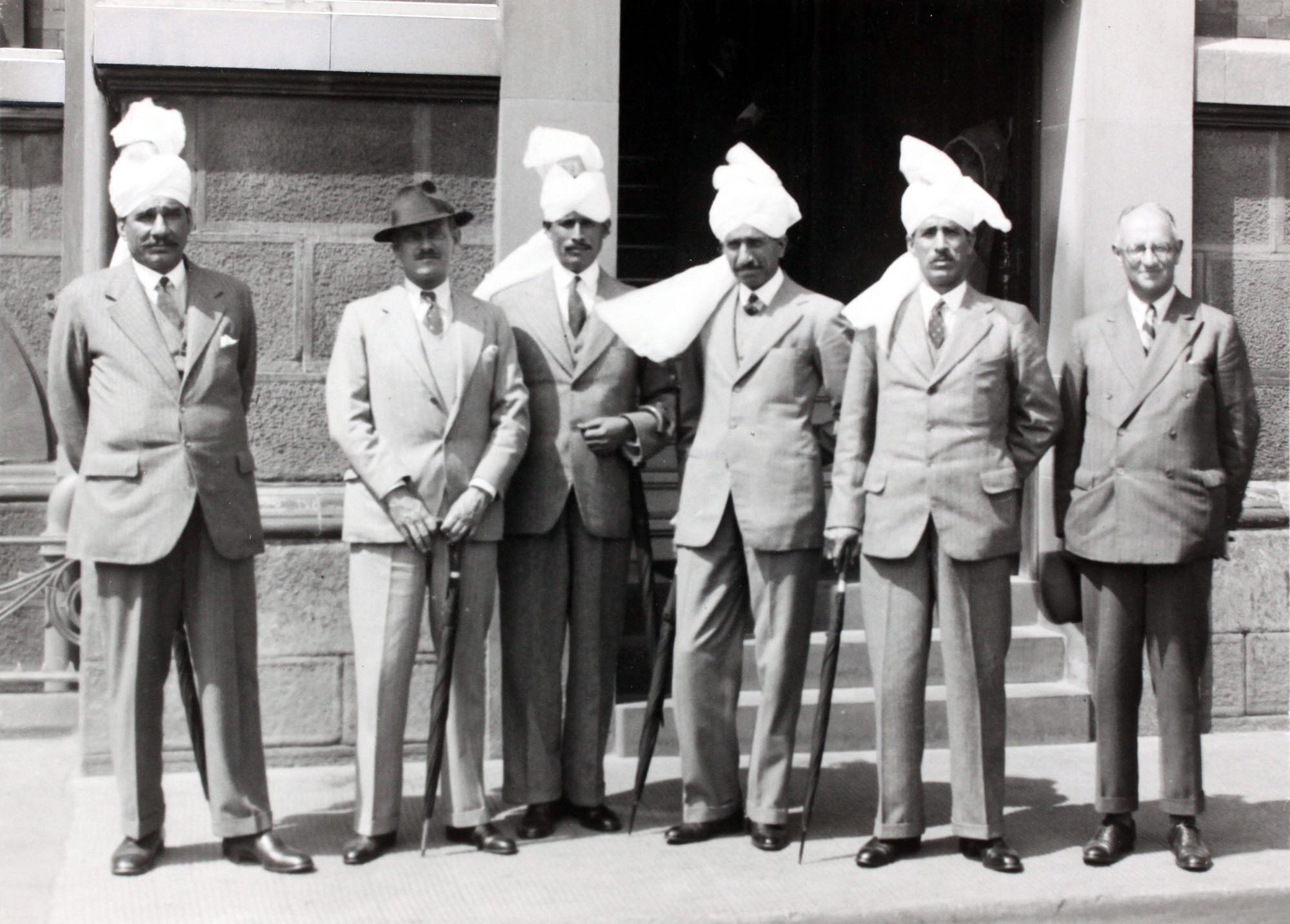
Manufacturing Pasts (University of Leicester)
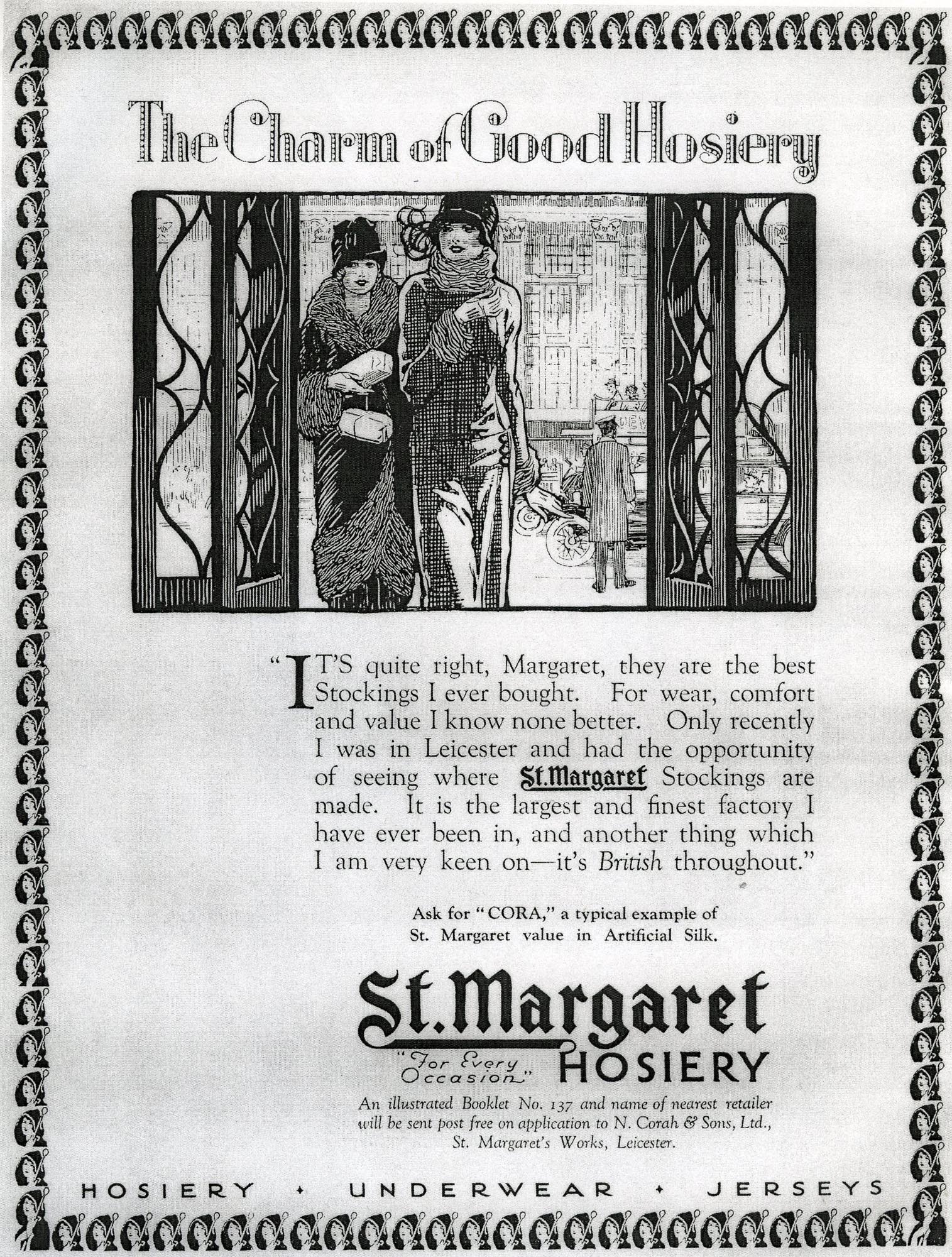
Victorian Society Archives

Manufacturing Pasts (University of Leicester)

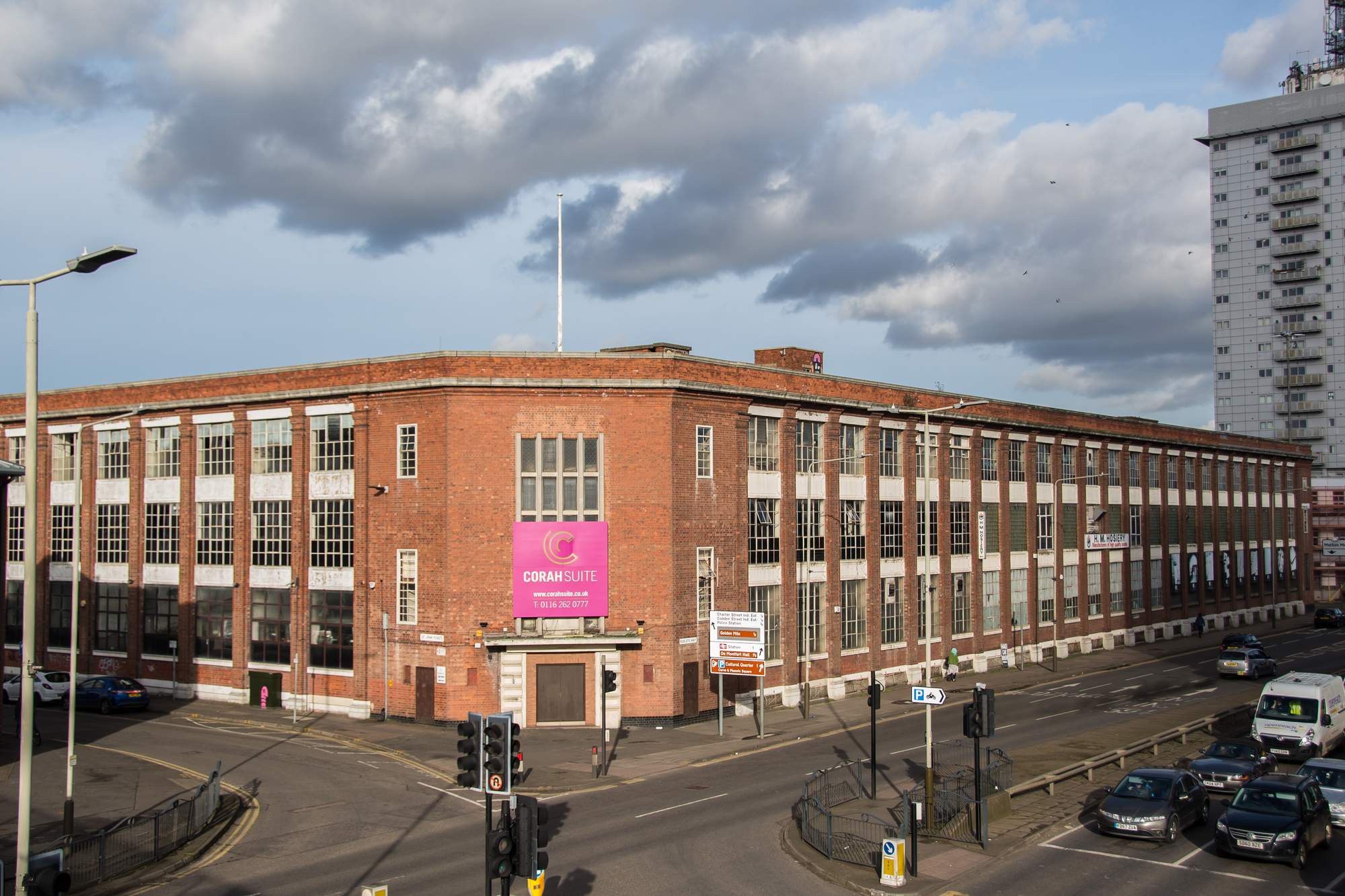
Roman Leicester
(47- 500) A military fort was erected, attracting traders and a growing civilian community to Leicester (known as Ratae Corieltauvorum to the Romans). The town steadily grew throughout the reign of the Romans.
Medieval Leicester
(500 – 1500) The early years of this period was one of unrest with Saxon, Danes and Norman invaders having their influences over the town. Later, of course, came Richard III and the final battle of the Wars of the Roses was fought on Leicester’s doorstep.
-
The Castle Motte1068

-
Leicester Cathedral1086

-
St Mary de Castro1107

-
Leicester Abbey1138

-
Leicester Castle1150

-
Grey Friars1231

-
The Streets of Medieval Leicester1265

-
Leicester Market1298

-
Trinity Hospital and Chapel1330

-
Bow Bridgecirca 1350

-
Church of the Annunciation1353

-
John O’Gaunt’s Cellar1361

-
St John's Stone1381

-
Leicester Guildhall1390

-
The Magazine1400

-
The Blue Boar Inn1400

-
The High Cross1577

Tudor & Stuart Leicester
(1500 – 1700) The wool trade flourished in Leicester with one local, a former mayor named William Wigston, making his fortune. During the English Civil War a bloody battle was fought as the forces of King Charles I laid siege to the town.
Georgian Leicester
(1700 – 1837) The knitting industry had really stared to take hold and Leicester was fast becoming the main centre of hosiery manufacture in Britain. This new prosperity was reflected throughout the town with broader, paved streets lined with elegant brick buildings and genteel residences.
-
Great Meeting Unitarian Chapel1708

-
The Globe1720

-
17 Friar Lane1759

-
Black Annis and Dane Hills1764

-
Leicester Royal Infirmary1771

-
New Walk1785

-
Freemasons’ Hall1790

-
Gaols in the City1791

-
Friars Mill1794

-
City Rooms1800

-
Development of Highfields1800

-
Wesleyan Chapel1815

-
20 Glebe Street1820

-
Charles Street Baptist Chapel1830

-
Glenfield Tunnel1832

-
James Cook1832

Victorian Leicester
(1837 – 1901) The industrial revolution had a huge effect on Leicester resulting in the population growing from 40,000 to 212,000 during this period. Many of Leicester's most iconic buildings were erected during this time as wealthy Victorians made their mark on the town.
-
Leicester Union Workhouse1839

-
Campbell Street and London Road Railway Stations1840

-
The Vulcan Works1842

-
Belvoir Street Chapel1845

-
Welford Road Cemetery1849

-
Leicester Museum & Art Gallery1849

-
King Street1850

-
Cook’s Temperance Hall & Hotel1853

-
Amos Sherriff1856

-
Weighbridge Toll Collector’s House1860

-
4 Belmont Villas1862

-
Top Hat Terrace1864

-
Corah and Sons - St Margaret's Works1865

-
Kirby & West Dairy1865

-
The Clock Tower1868

-
Wimbledon Works1870

-
The Leicestershire Banking Company1871

-
St Mark’s Church and School1872

-
Victorian Turkish Baths1872

-
The Town Hall1876

-
Central Fire Stations1876

-
Aylestone Road Gas Works and Gas Museum1879

-
Gas Workers Cottages1879

-
Leicestershire County Cricket Club1879

-
Welford Road Tigers Rugby Club1880

-
Secular Hall1881

-
Development of Highfields1800

-
Abbey Park1881

-
Abbey Park Buildings1881

-
Victoria Park and Lutyens War Memorial1883

-
Leicester Fosse FC 18841884

-
Leicester Coffee and Cocoa Company Coffee Houses1885

-
St Barnabas Church and Vicarage1886

-
Abbey Pumping Station1891

-
Luke Turner & Co. Ltd.1893

-
West Bridge Station1893

-
Thomas Cook Building1894

-
The White House1896

-
Alexandra House1897

-
Leicester Boys Club1897

-
Grand Hotel and General Newsroom1898

-
Highfield Street Synagogue1898

-
Western Park1899

-
Asfordby Street Police Station1899

-
Leicester Central Railway Station1899

Edwardian Leicester
(1901 – 1910) Electric trams came to the streets of Leicester and increased literacy among the citizens led to many becoming politicised. The famous 1905 ‘March of the Unemployed to London’ left from Leicester market when 30,000 people came to witness the historic event.
-
YMCA Building1900

-
The Palace Theatre1901

-
Pares's Bank1901

-
Coronation Buildings1902

-
Halfords1902

-
High Street1904

-
George Biddles and Leicester's Boxing Heritage1904

-
Municipal Library1905

-
Leicester Boys Club1897

-
The Marquis Wellington1907

-
Guild Hall Colton Street1909

-
Women's Social and Political Union Shop1910

-
Turkey Café1901

Early 20th Century Leicester
(1910 – 1973) The diverse industrial base meant Leicester was able to cope with the economic challenges of the 1920s and 1930s. New light engineering businesses, such as typewriter and scientific instrument making, complemented the more traditional industries of hosiery and footwear manufacturing.
-
Dryad Handicrafts1912

-
De Montfort Hall1913

-
Leicester During the First World War1914

-
Fox’s Glacier Mints1918

-
Statue of Liberty1919

-
Housing in Saffron Lane1924

-
Winstanley House1925

-
Housing in North Braunstone1926

-
Lancaster Road Fire Station1927

-
The Little Theatre1930

-
Saffron Hill Cemetery1931

-
Braunstone Hall Junior School1932

-
Former City Police Headquarters1933

-
Savoy Cinema1937

-
Eliane Sophie Plewman1937
-
City Hall1938

-
Athena - The Odeon Cinema1938

-
The Blitz in Highfields1940

-
Freeman, Hardy and Willis - Leicester Blitz1940

-
Leicester Airport1942

-
Leicester’s Windrush Generations1948

-
Netherhall Estate1950
-
Housing at Eyres Monsell1951

-
Silver Street and The Lanes1960

-
Bostik1960

-
Auto-Magic Car Park (Lee Circle)1961

-
University of Leicester Engineering Building1963

-
Sue Townsend Theatre1963

-
Central Mosque1968

-
Belgrave Flyover1973

Modern Leicester
(1973 – present day) Industry was still thriving in the city during the 1970s, with the work opportunities attracting many immigrants from all over the world. While industry has declined in recent years, excellent transport links have made Leicester an attractive centre for many businesses. The City now has much to be proud of including its sporting achievements and the richness of its cultural heritage and diversity.
-
Haymarket Theatre1973

-
The Golden Mile1974

-
Acting Up Against AIDS1976

-
Belgrave Neighbourhood Centre1977

-
Diwali in Leicester1983

-
Leicester Caribbean Carnival1985

-
Samworth Brothers1986

-
Jain Centre1988

-
Guru Nanak Dev Ji Gurdwara1989

-
King Power Stadium2002

-
LCB Depot2004

-
Curve2008

-
BAPS Shri Swaminarayan Mandir2011

-
Makers Yard2012

-
VJ Day 80th Anniversary2020

- Roman Leicester
- Medieval Leicester
- Tudor & Stuart Leicester
- Georgian Leicester
- Victorian Leicester
- Edwardian Leicester
- Early 20th Century Leicester
- Modern Leicester
A Working Town
















































































































































